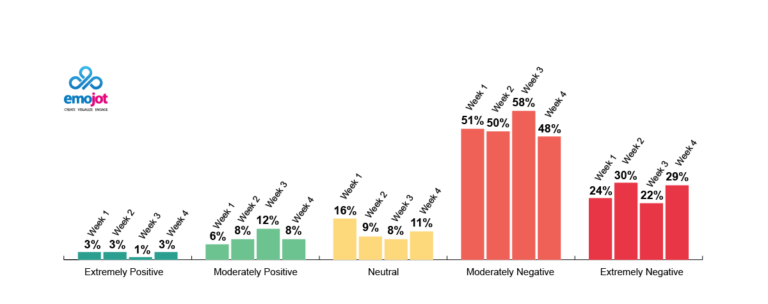
Emojot Powers the Weekly Business Temperature of COVID-19 Impact on Silicon Valley Companies
Data-driven insight is powerful, particularly in a crisis! People, businesses, and governments around the world are dealing with the paralyzing effect caused by the Covid-19 pandemic. These effects manifest and change daily! In such a significantly changing landscape, the need to understand the substantial impact of the crisis on companies is very important. The strategies and critical decisions that businesses adopt to deal with the impact on their corporate financial ‘health’ inevitably have an effect on the larger state and country economies. The San Francisco Bay Area’s Alliance of Chief Executives have weathered through 2 other major crises in their 24-year history – the 2000 dot.com crash and the 2008 world financial crisis. But now they face possibly the most serious crisis! According to Paul Witkay, the Founder and CEO of the Alliance of CEOs, “Although no one enjoys these crises, my experience has been that times like these force CEOs to think more creatively and generate more counter-intuitive strategies.” In classic Silicon Valley-style, the Alliance of CEOs swung into action in mid-March, by deciding to launch a weekly business sentiment trend analysis with a 1-minute CEO Business Trends Survey. The results are published within 24 to 36 hours of deployment, every week. Their objective is to leverage this weekly trend analysis of how Bay Area CEOs are experiencing the COVID-19 crisis to help them all plan more effectively and make better decisions. Additionally, the survey engagement was designed to provide an easy way to let the CEO Alliance leadership know if their company executives had any questions or challenges that might be helped by someone else in the Alliance community of CEOs. How has your business changed during the pandemic?[emojot type = “button” size=”small” key=”5770bdd408a69b2050a9764f” id=”5770bba70409e08c75a46b04_5ecf8361bcf5270010920cf1″ clientid=”TxflwzfAaMujFELGh_egokuaUnAa” clientsecret=”db6b2R0xXbw9dgU9Ig7pHfh6AMoa”] The CEO Alliance uses the Emojot platform, to efficiently deploy these […]



